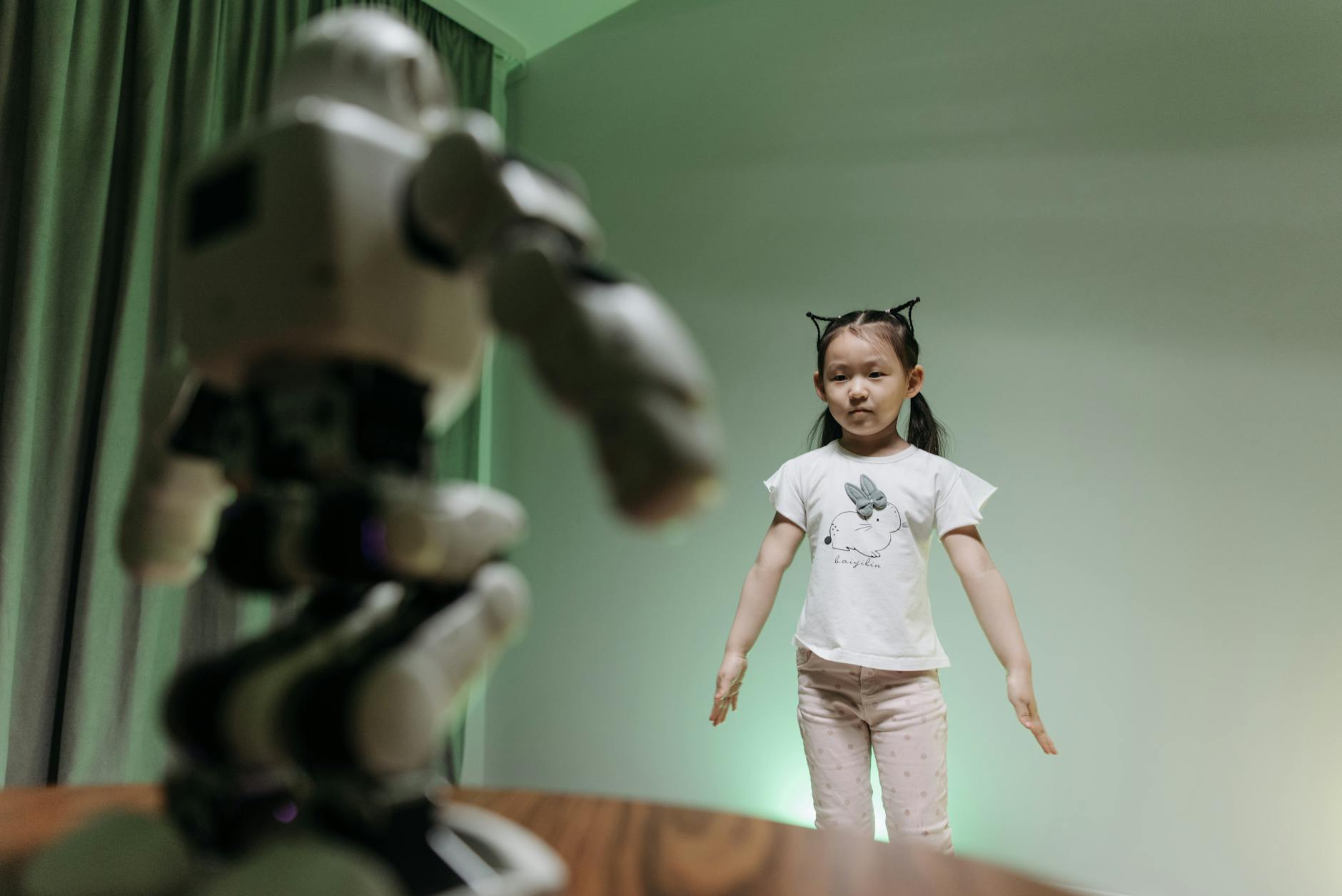Beginners Guide to Artificial Intelligence
Understanding AI Basics
Introduction to Artificial Intelligence
Artificial intelligence, or AI if you’re all fancy, is shaking things up. Imagine machines seeing, speaking, and even understanding language—kinda like your favorite translator app but with a high IQ. Whether it’s figuring out what you’re saying, crunching numbers, or suggesting your next binge-worthy show, AI’s got its paws in it all Google Cloud. AI’s basically having machines do human-like stuff like thinking, learning on the fly, planning, and even getting creative European Parliament.
AI learns from previous actions, adapting like your GPS rerouting after a wrong turn. It’s taking over everything from hospitals to banks to how we zoom around, changing our daily grind big time Coursera.
Evolution of AI Technologies
AI’s all grown up thanks to beefier computers, more data than you can shake a stick at, and slicker algorithms. It’s leading the tech revolution, especially in places like the EU European Parliament).
Back in the day, AI was like a calculator on steroids, handling symbols like a pro. But now it’s more about machine learning, where computers soak up data and improve all the time, kinda like how you get better at video games (Coursera).
Here’s the lowdown on modern AI:
| AI Type | Description |
|---|---|
| Artificial Narrow Intelligence (ANI) | Task-master for specific jobs |
| Artificial General Intelligence (AGI) | Thinks on par with us humans |
| Artificial Superintelligence (ASI) | Way smarter than any of us |
As AI gets smarter, it’s starting to become more like a teammate tackling tough challenges and sparking new ideas.
Types of Artificial Intelligence
Artificial Intelligence (AI) can be sorted into three main flavors: Artificial Narrow Intelligence (ANI), Artificial General Intelligence (AGI), and Artificial Superintelligence (ASI). Getting to know these types helps clear up the mysteries around artificial intelligence, especially for those just getting started.
Artificial Narrow Intelligence (ANI)
Known as the AI we deal with today, Artificial Narrow Intelligence (ANI) is built to tackle one thing or a tight set of tasks with speed and precision that us humans only dream of. It’s like that super-focused employee who gets one job done perfectly but doesn’t stray beyond the task at hand.
Common examples of ANI include:
- Siri and Amazon Alexa: These are your friendly neighborhood voice assistants, doing jobs like setting reminders, answering random trivia, and controlling those nifty smart home gadgets.
- IBM Watson: This brainy AI whiz analyzes mountains of data to spill the beans in fields like healthcare and finance.
| AI System | Tasks |
|---|---|
| Siri | Sets reminders, answers questions |
| Amazon Alexa | Manages smart home devices |
| IBM Watson | Crunches numbers in healthcare and finance |
Artificial General Intelligence (AGI)
Picture AGI as the next big leap in AI evolution. This kind of intelligence would step up to handle anything you can throw at it, just like humans can. It’s the kind of AI that would not only learn from past experiences but apply that wisdom to solve new problems (IBM).
As of now, AGI is still playing hard-to-get. It’s a major research topic aimed at developing systems that can:
- Sense, Think, and React: Basically like having a human brain inside a machine.
- Learn and Evolve on Their Own: Picking up new tricks and knowledge without needing a nudge from us.
Artificial Superintelligence (ASI)
Let’s talk sci-fi future with Artificial Superintelligence (ASI), which would leave even the smartest human brain in the dust. This type of AI would be aware of itself, maybe even wondering about the meaning of machine life, while outsmarting us in every possible way (BuiltIn).
Some highlighted features of ASI include:
- Next-Level Brain Power: Solving puzzles and making decisions we haven’t dreamed of yet.
- Limitless Learning: Continuously expanding and building knowledge well past our own capabilities.
Though ASI is still just a glimmer in our sci-fi imaginations, the buzz is about how it might change the game—like a world overhaul, bringing crazy advancements in science and tech. For now, it remains a bright idea and an exciting research playground.
| Type of AI | Description | Status |
|---|---|---|
| Artificial Narrow Intelligence (ANI) | Made for specific tasks | In action today |
| Artificial General Intelligence (AGI) | Mimics human-like smarts | Still dreaming and exploring |
| Artificial Superintelligence (ASI) | Surpasses human brainpower | Just a brilliant idea for now |
Knowing these AI types helps people get a clearer view of what AI can and can’t do, setting the stage for smarter chats and breakthroughs in the tech world.
Functional AI Categories
Artificial Intelligence (AI) is like a toolbox with different gadgets, each with its own capabilities and areas of expertise. Let’s unpack some of these AI types and see where they might fit in our everyday lives.
Reactive Machine AI
Start with Reactive Machine AI, the plain vanilla in the AI sundae. This type of AI is great at keeping things simple—responding swiftly to particular inputs. Trouble is, it has no memory, like that goldfish you just can’t train. Think of it as your fancy spam filter—it spots the junk and tosses it, pronto. Or remember Deep Blue? It took out a chess master by strictly following the playbook, no recollection involved.
| Features | Reactive Machine AI |
|---|---|
| Memory | No |
| Learning Ability | No |
| Applications | Spam Filtering, Basic Recommendations |
| Examples | Programs like IBM’s Deep Blue for playing chess |
Limited Memory AI
Limited Memory AI steps up the game by checking the rearview mirror. It logs past data to make smarter calls—still a bit short on long-term memory, but every bit counts. It’s the type of mind behind self-driving cars, juggling speed, and directions like a pro by remembering what’s been. It’s also in fraud detection systems, drawing on patterns it’s seen before to keep your wallet safe.
| Features | Limited Memory AI |
|---|---|
| Memory | Yes (Limited) |
| Learning Ability | Yes |
| Applications | Self-driving Cars, Fraud Detection Systems |
| Examples | Tesla’s Autopilot |
Theory of Mind AI
This AI carries empathy in its toolkit, like a friend who gets your mood before you do. Theory of Mind AI aims to read human emotions and intentions—a brainy confidant still in the works. Once polished, it could charm its way into places like customer service or therapy, where understanding a frown from a smile is gold.
| Features | Theory of Mind AI |
|---|---|
| Memory | Yes |
| Learning Ability | Yes |
| Emotional Understanding | Yes |
| Potential Applications | Social Robotics, Mental Health Support Systems |
Self-Aware AI
The holy grail of AI would be Self-Aware AI—a smarty-pants with a sense of self. Picture an AI who knows it’s an AI and can ponder about its own lines of code. It’s a concept that might sound like sci-fi, but it’s the dream… and the dread. If ever realized, it could blaze new trails but also open a can of ethical worms.
| Features | Self-Aware AI |
|---|---|
| Memory | Yes |
| Learning Ability | Yes |
| Self-awareness | Yes |
| Potential Applications | Autonomous systems beyond current boundaries, Ethical AI development debates |
Cracking open these AI categories isn’t just academic—it’s like having a map to navigate where technology is headed. Every type made a giant leap from the last, promising to tweak, twist, and utterly change the face of our gadgets and gizmos. So, whether you’re just getting started or you’re a digital denizen, there’s a lot to explore in this brave new AI-fueled adventure.
Learning about Machine Learning
Imagine giving computers the brains to guess, predict, and learn on their own—that’s the magic of Machine Learning. It’s a branch of Artificial Intelligence where computers are taught to make sense of data and come up with predictions or choices, without being told every step along the way. Let’s dive into the three big players in this game: supervised learning, unsupervised learning, and reinforcement learning.
Supervised Learning
In the world of supervised learning, think of it like an apprentice shadowing a master. You have a bunch of examples with answers that show the algorithm the ropes, teaching it how to see patterns and make educated guesses on new stuff it hasn’t seen before.
Key features include:
- Needs examples with answers (labeled data)
- Figures out results based on what it’s learned
- Handy for sorting things into categories and making predictions
Supervised learning packs a punch with algorithms like Decision Trees, Support Vector Machines (SVM), and Linear Regression. It’s the brains behind tasks like spotting spam emails, teaching computers to recognize faces, and even helping doctors diagnose diseases.
Unsupervised Learning
Unsupervised learning is like exploring a jungle without a map. The algorithm has no labels to guide it. It’s left to wander through data, sniffing out patterns and structures hidden within.
Key traits:
- Works with data that doesn’t have labels
- Digs out hidden gems and structures
- Often involved in grouping (clustering) and finding connections (association)
Clustering and Association
Clustering is like sorting your laundry—grouping similar data points together. K-means Clustering, for example, sorts information into clusters based on common traits.
Ever noticed how stores suggest items to buy along with your shopping list? That’s association at work, finding out what things often go together, like cookies and milk.
Reinforcement Learning
Reinforcement learning puts an agent in the driver’s seat, encouraging it to take actions, make mistakes, and learn from the hits and misses, all to score big rewards (Google Cloud). It’s like training a dog—give a treat for fetching the ball, and a stern no-no if it chews your shoe.
Main attributes:
- Learns from trial and error
- Aims to rack up points (rewards)
- Involves acting within an environment, making choices, and responding to situations
Key Components of Reinforcement Learning
- Agent: The decision-maker, kind of like the captain of the ship.
- Environment: The territory or scenario the agent navigates.
- Actions: The moves the agent can make.
- States: The various scenarios the agent encounters.
- Rewards: The feedback given for good or bad moves.
Reinforcement learning shines in tasks where picking a series of good choices is the secret sauce, like robots learning to dance, mastering video games, or cars figuring out how to drive themselves.
| Learning Type | Data Type | Common Applications |
|---|---|---|
| Supervised Learning | Labeled | Email filtering, Photo recognition |
| Unsupervised Learning | Unlabeled | Customer profiling, Suggestion engines |
| Reinforcement Learning | Feedback-based | Robotics training, Game strategies, Self-driving vehicles |
Grasping these core techniques is the first step to lifting the fog around artificial intelligence and letting new learners get their toes wet.
Exploring Artificial Neural Networks
Artificial Neural Networks (ANNs) are a big chunk of what makes AI tick, working somewhat like the human brain by mimicking its information processing. We’re breaking down three popular types of neural networks: Feedforward Neural Networks (FF), Recurrent Neural Networks (RNN), and Long/Short Term Memory (LSTM) networks.
Feedforward Neural Networks (FF)
Feedforward Neural Networks are the basic building blocks of neural networks. In these setups, info flows one way—from the input to the output—without any looping back.
- FF networks are often used for stuff like recognizing images, spotting patterns, and handling basic classification tasks.
- They operate in a straight line, not relying on what came before.
Example of Use
Feedforward Networks are like a good pair of eyes for a computer; they help in sorting out whether a picture shows a cat or a dog.
| Task | Performance | Complexity |
|---|---|---|
| Image Recognition | High | Moderate |
| Pattern Recognition | High | Moderate |
Recurrent Neural Networks (RNN)
Recurrent Neural Networks step it up by working with sequences, making them perfect for tasks that need to remember stuff, like time series data or sentences.
- RNNs are your go-to for language models, prediction sequences, and making sense of speech.
- These guys have a little brain of their own, kind of like a memory, to help with input sequences.
Example of Use
RNNs are champs at language translation. They take a sentence, chew over the whole set of words, and pop out an accurate translation.
| Task | Performance | Complexity |
|---|---|---|
| Language Modeling | High | High |
| Sequence Prediction | High | High |
Long/Short Term Memory (LSTM)
LSTM networks are a special breed of RNN that remember things for a long time. They solve some of the “I forgot” issues RNNs have with long-term info.
- LSTM networks shine when dealing with long sequences, like predicting future trends, recognizing handwriting, and understanding speech.
- They’re equipped with memory cells, helping them keep info in mind throughout lengthy sequences.
Example of Use
LSTMs are pros at speech recognition, nailing that long, rambly audio and translating it into something understandable.
| Task | Performance | Complexity |
|---|---|---|
| Time-Series Forecasting | High | Very High |
| Speech Recognition | Very High | Very High |
Artificial Neural Networks like Feedforward, Recurrent, and Long/Short Term Memory networks are essential in helping AI mimic how we think and learn. Getting to grips with these networks opens the door to understanding how AI acts like our brains do (Google Cloud, IBM).
Applications of AI in Daily Life
Artificial intelligence is weaving its magic into our routines, popping up like an unexpected guest in sectors we depend on daily. So, let’s chat about how AI is getting things done—especially in healthcare and transportation.
AI in Various Industries
AI isn’t just sci-fi anymore; it’s in your pocket and fridge, making life snazzier. Let’s dish the dirt on some places AI’s setting up shop:
- Online Shopping and Ads: Ever wonder how those ads are eerily spot-on? AI’s got eyes on your buying habits, serving up products you’d probably click “add to cart” on.
- Web Searches: Say goodbye to rogue search results. AI tweaks search engines so you’re not sifting through nonsense.
- Digital Helpers: “Hey Siri” isn’t just a catchphrase. These little buddies settle disputes over dinner, remind you about Aunt Sally’s birthday, and give weather updates.
- Smart Homes: If your home is talking to you, don’t freak out. AI’s making sure your lights and heat understand your mood.
- Smart Cities and Infrastructure: AI keeps traffic jams from driving you bonkers and helps cities operate smoother than a slick slide.
- Cybersecurity: AI whiz kids are busting digital crooks, sniffing out threats quicker than a watchdog.
- Manufacturing: Robots aren’t just for movies—they’re on the factory floor, predicting when machines might take a nap.
- Food and Farming: AI’s the brain behind bumper harvests and your favorite snack arriving fresh and yummy.
AI in Healthcare and Transportation
When it comes to healthcare and commute, AI’s like your go-to superhero, always ready to help.
AI in Healthcare
In healthcare, AI is your behind-the-scenes genius, offering sharper diagnostics, treatment plans with your name on them, and streamlined hospital operations.
- Medical Imaging: AI’s like the detective of the medical world, spotting trouble in places where even eagle-eyed doctors might miss.
- Predictive Analytics: Think of AI as your health horoscope; it predicts where diseases might strike next and flags if you’ve got any health red flags.
- Telemedicine: AI-powered video calls make doctor visits a breeze, even if you’re miles away from the nearest clinic.
- Emergency Services: AI stands guard, picking up on emergency calls and acting swiftly like a seasoned paramedic European Parliament.
AI in Transportation
Hop in the passenger seat because AI’s driving the change on our roads, making every trip just a bit safer and more efficient.
- Autonomous Vehicles: Self-driving cars be like, “You just chill, I got this,” aiming for fewer screeching brakes and dented bumpers.
- Traffic Management: AI’s mission is clear: fewer horns blaring in gridlock. It tweaks lights and routes, making drives less of a headache.
- Public Transport: Ever noticed your bus showing up when you need it? Chalk it up to AI’s scheduling skills.
- Logistics: AI streamlines deliveries like a postman on a caffeine high, ensuring packages land on your doorstep, right on cue.
| What’s the Buzz | Example What-It-Do’s |
|---|---|
| Healthcare | Peeking inside bodies (Medical Imaging), Spotting trends (Predictive Analytics), Virtual doc calls (Telemedicine), Alerting emergencies (Emergency Services) |
| Transportation | Driving sans hands (Autonomous Vehicles), Traffic choreography (Traffic Management), Predictable buses/trains (Public Transport), Swift deliveries (Logistics) |
| Cybersecurity | Digital bouncers (Threat Detection), On-the-spot defense (Real-Time Response) |
| Smart Homes | Easy-peasy automation (Lighting, Heating, Security) |
| Online Shopping | Spot-on product pitches (Personalized Recommendations, Targeted Ads) |
| Manufacturing | Robot replacements (Automation), Fixing before breaking down (Predictive Maintenance) |
| Food and Farming | Bumper crops (Crop Yield Optimization), Shelf-stock smarts (Supply Chain Management) |
AI is the secret sauce in modern life’s recipe, keeping things fresh and exciting. By peeling back the techy layers, anyone curious can grasp its enormous effect and the promising paths yet to be traveled.
AI Breakthroughs and Enhancements
Impact of AI Advancements
AI’s really taken off thanks to supercharged computer power, more data than ever, and brainy new algorithms. It’s turning heads and shaking things up, making it a go-to on the EU’s to-do list (European Parliament).
AI’s finger is in a lot of pies now:
- Healthcare: It’s like having a doc in your device, helping with diagnostics and patient plans.
- Finance: It’s the new Wall Street whiz, boosting trading and managing money matters.
- Transportation: Think smart maps and cars that know the way better than your uncle.
- Retail: It’s the secret behind that perfect product suggestion, tightening up shopping experiences.
Here’s how AI is stepping into different industries:
| Sector | AI in Action |
|---|---|
| Healthcare | Boosts in diagnostics, custom care |
| Finance | Slick trading, friendly customer service |
| Transportation | Cars that think, smooth traffic flow |
| Retail | Shop smarts, spot-on inventory |
AI in Covid-19 Response
Through the Covid rollercoaster, AI showed it’s not just a lab-only tech. It stepped onto the frontlines, taking a solid crack at the chaos:
- Thermal Imaging: Cameras smart enough to spot feverish folks in crowded spots (Boston University).
- Lung Scans: AI became a lung detective, speeding up infection diagnosis with a digital eye (European Parliament).
- Data Crunching: Made sense of the massive data, spotting trends, and helping plot the next move (European Parliament).
- Emergency Calls: Fast-tracked call diagnosis, like dialing up a life-saving hotline (European Parliament).
Through these nerve-wracking times, AI proved it could step up and tackle heavyweight global challenges. As it stretches its digital wings further, expect it to weave more into everyday life, lending a hand in ways we’re just starting to imagine.
Awareness and Adoption of AI
Public Awareness of AI
When it comes to artificial intelligence, folks have different levels of understanding. Based on a study by Pew Research, nearly half of Americans think they don’t bump into AI on the regular. This shows how folks get along with AI at different speeds in their everyday hustle.
Another peek by Pew Research digs deeper, showing:
- 30% of folks in America nailed all six questions about AI in daily life.
- 38% got three to five right answers.
- 31% struggled with just two or fewer right ones.
These numbers paint a picture of how differently people get AI.
Younger folks, especially those between 18 and 29, seem to have a better handle on spotting AI. Check this out:
- 75% could spot AI when dealing with customer service chatbots.
- 65% recognized AI in music playlist suggestions.
Looks like the younger crowd’s got more of a handle on AI tech.
Education and Income Levels Relation
How well you know AI seems to depend on how much schooling you’ve had and your paycheck. Pew Research points out that people with more schooling and bigger incomes get AI better in their daily shuffle.
| Education Level | Correctly Identifying AI Uses (All Six Questions) |
|---|---|
| Postgraduate Degree | 53% |
| High School Diploma or Less | 14% |
The numbers in the table show that folks with more schooling tend to know more about AI.
Money talks when it comes to AI smarts too. Those with bigger paychecks usually have more tech and learning stuff handy. That makes it easier for them to get AI.
What all this tells us is that we need more learning stuff out there to clear up AI for everyone, especially beginners. Getting the word out can help shrink the difference in AI know-how among different folks.













